Key takeaways:
- Sustainable shopping involves making conscious purchasing decisions that benefit both individuals and the environment.
- Consumer choices have a significant impact on ocean health, marine ecosystems, and the livelihoods of communities dependent on fishing.
- Identifying and supporting brands with genuine eco-friendly practices fosters a more sustainable economy.
- Practical steps for sustainable shopping include creating checklists, exploring second-hand options, and prioritizing needs over wants.
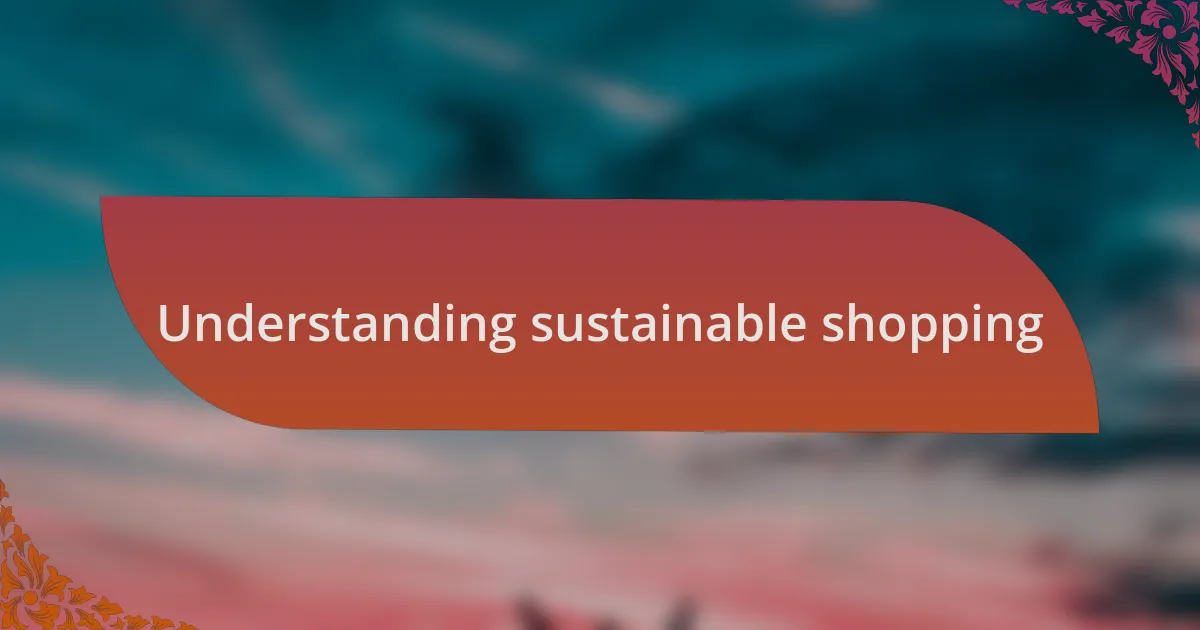
Understanding sustainable shopping
Sustainable shopping is about making choices that are not only good for us but also for the planet. I still remember the moment I realized that my purchasing decisions had a ripple effect on the environment. Walking through a store filled with plastic-wrapped products, I couldn’t help but think: what legacy am I leaving behind if I keep supporting practices that harm our oceans?
It’s not just about choosing products labeled as “eco-friendly.” Sometimes, the most sustainable option may be buying second-hand or supporting local artisans who prioritize ethical practices. When I found a vintage store tucked away in my neighborhood, I felt a sense of excitement—not just for the unique items I discovered, but for the opportunity to reduce waste and support a more sustainable economy.
As I embraced sustainable shopping, I began asking myself questions like, “How often will I use this? What impact will it have on our planet?” These reflections turned my shopping trips into thoughtful experiences, transforming what used to be simple purchases into conscious decisions. Have you ever paused to consider how your choices might protect marine life? This journey is personal, and each purchase can be a step toward a healthier ocean.
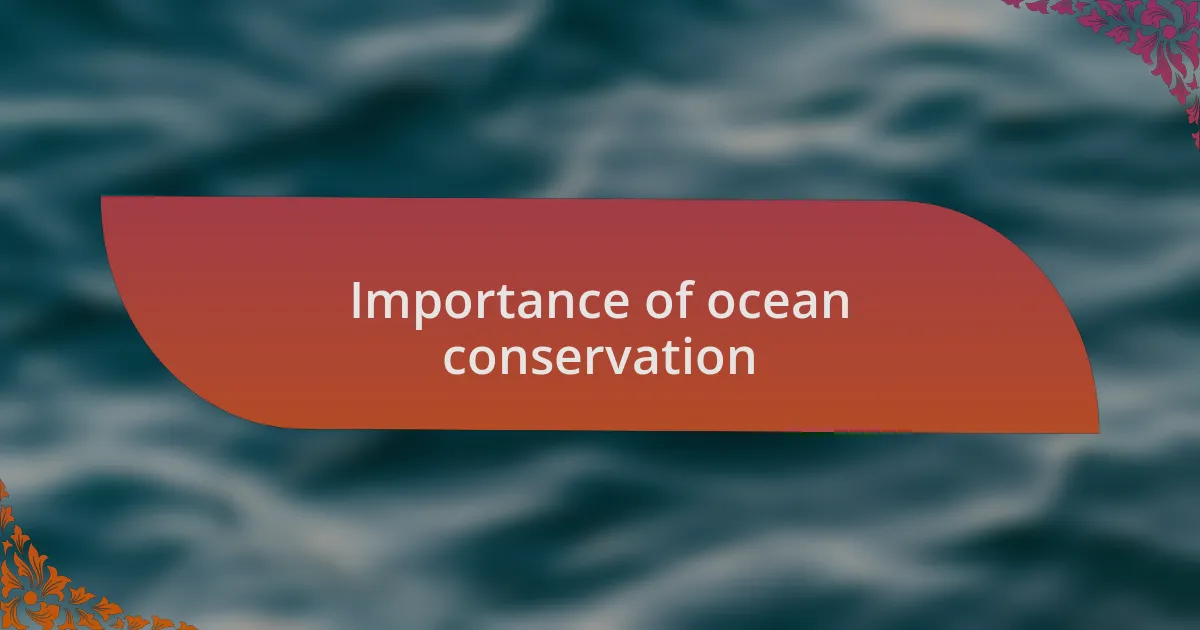
Importance of ocean conservation
The health of our oceans is paramount to the overall well-being of our planet. I recall a time when I stood by the shoreline, watching the waves crash against the rocks, realizing that the oceans produce over half of the world’s oxygen. This critical role highlights how closely our existence is tied to the health of marine ecosystems, reminding me that protecting them is essential for future generations.
Consider this: our oceans are not just a resource; they are a fragile ecosystem teeming with life. I’ll never forget the first time I snorkeled among coral reefs, mesmerized by the vibrant colors and diverse species swimming around me. The thought of pollution and climate change threatening these underwater wonders filled me with a sense of urgency. It made me question what I could do to advocate for ocean conservation and protect these fragile habitats.
Furthermore, healthy oceans are vital for food security and economic stability for millions worldwide. When I learned that countless communities depend on fishing for their livelihoods, it deepened my understanding of the stakes involved. What if our shopping habits could either support or undermine these livelihoods? This realization propelled me to become more intentional in my consumer choices, understanding that each decision I make carries the weight of responsibility not just to myself, but to the wider world, particularly the oceans that connect us all.
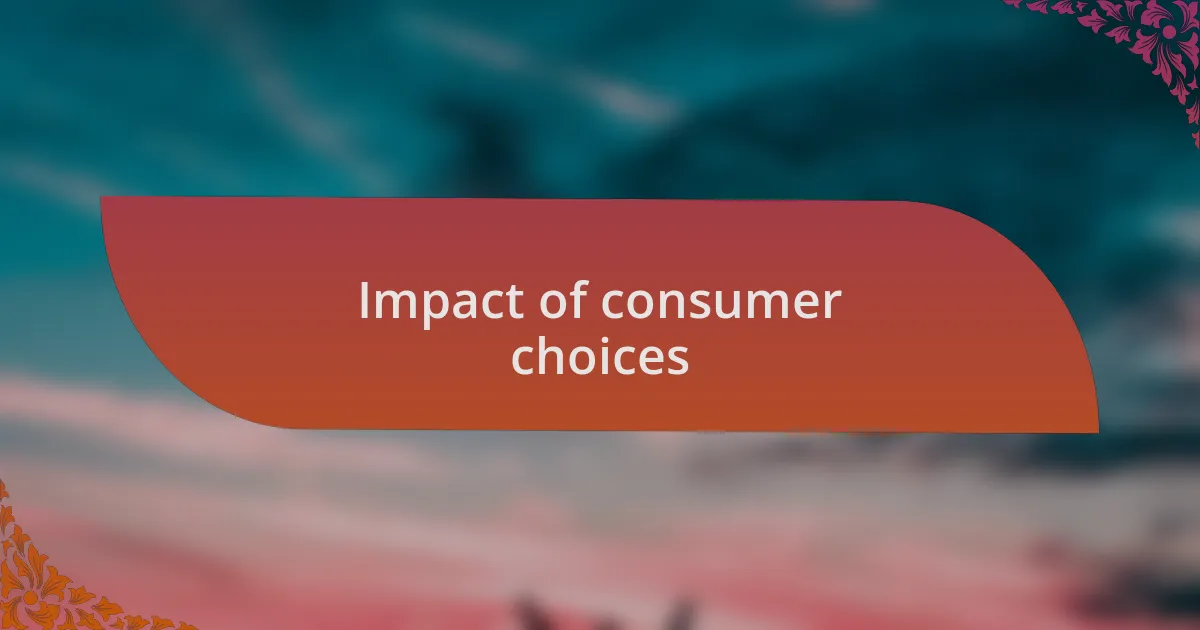
Impact of consumer choices
Every purchase I make carries a loaded responsibility that often goes unnoticed. I remember a time while shopping for seafood when I paused, wondering if the fish I selected had been sustainably sourced. The reality is that choosing products with eco-friendly labels not only safeguards marine life but also influences the fishing practices that communities rely on for their survival. It made me think—how often do I consider the stories behind my food?
Consumer choices ripple through the economy, impacting everything from fishing practices to packaging waste. I was shocked to learn that a single plastic bottle could take hundreds of years to decompose, ultimately finding its way back to the marine environment. It was a wake-up call that inspired me to seek out reusable alternatives. Reflecting on this, one can’t help but ask: how can we shift our habits to better protect our oceans?
Moreover, every decision I make at the checkout line feels like a vote for what I support in the world. I vividly recall standing there, contemplating whether to choose a product wrapped in excessive plastic or one that came in biodegradable packaging. This simple choice sparked deeper thoughts about the cumulative impact of our shopping habits. Each dollar spent is a chance to advocate for a healthier planet—shouldn’t we choose wisely?
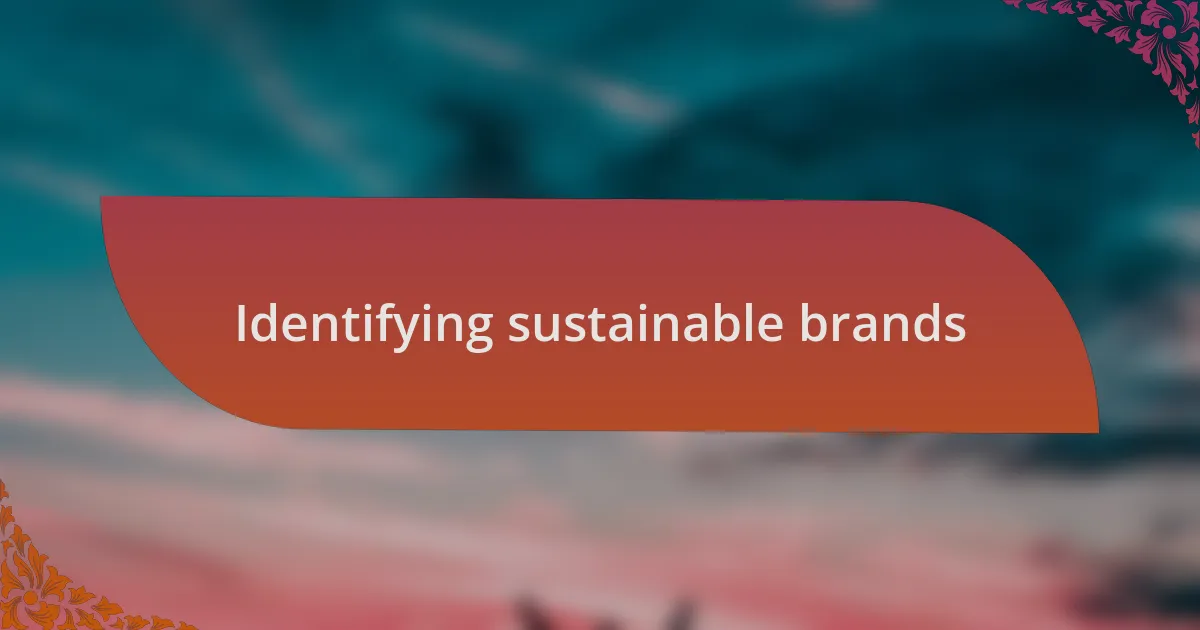
Identifying sustainable brands
When I began my journey toward sustainable shopping, I realized the importance of looking for brands that genuinely commit to eco-friendly practices. I remember when I stumbled upon a clothing line that not only emphasized organic materials but also shared transparency about their supply chain. This openness made me feel more connected to the garments I chose, transforming my shopping experience into an act of mindfulness rather than just a transaction.
Researching brands can often feel overwhelming, but I found that focusing on certifications like Fair Trade or GOTS (Global Organic Textile Standard) helps narrow down my options. I distinctly recall feeling a sense of relief when I discovered a local coffee brand that sourced its beans from sustainable farms. Knowing that my morning ritual was supporting ethical farming practices ignited a passion within me to keep seeking out similar brands. Doesn’t it feel good to invest in products that align with your values?
Moreover, I’ve learned to trust my instincts when evaluating a brand’s commitment to sustainability. For instance, I used to gravitate toward trendy products without questioning their environmental impact. But after watching a documentary about the fashion industry’s wastefulness, I couldn’t shake the feeling of dissonance it created. Now, if a brand’s marketing feels more focused on aesthetics than ethics, I often ask myself: Is this truly a choice worth making for our planet?
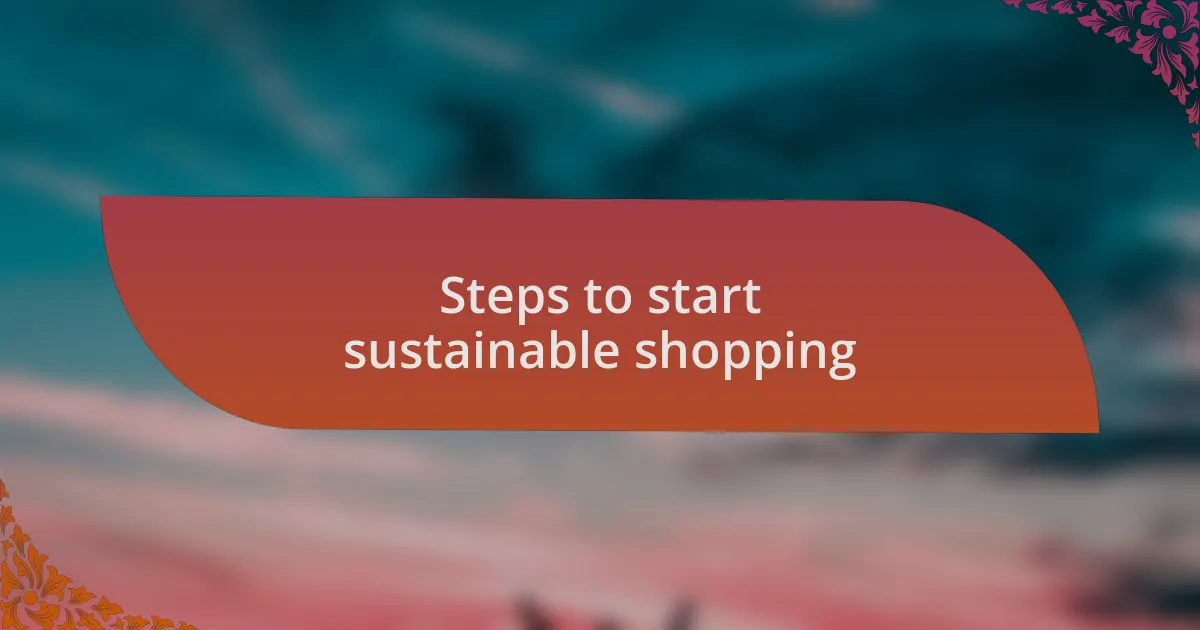
Steps to start sustainable shopping
One of the first steps in my sustainable shopping journey was to create a checklist of criteria that I used whenever I shopped. I found it helpful to ask myself questions like, “Does this product use sustainable materials?” or “What’s the brand’s stance on fair labor practices?” I remember standing in a local store, holding a beautiful handbag, but hesitating when I recalled my checklist. That moment really drove home the importance of having clear standards; it made my decision feel more intentional.
I also started keeping track of local markets and second-hand shops in my area. Exploring these places not only made shopping more adventurous but also helped reduce waste. There was one Saturday when I snagged an exquisite vintage jacket that not only fit perfectly but also had a story behind it. Each time I wear it, I’m reminded of the unique history it carries, making my choice feel richer and more meaningful. Have you considered how second-hand shopping can play a role in your sustainable journey?
Lastly, I began to prioritize needs over wants, which is a game-changer. I recall a period where I would impulsively buy the latest gadget, only to use it sparingly. Now, I pause to reflect on what I truly need and how it affects the environment. This shift not only saves me money but has also fostered a deeper appreciation for the items I choose to bring into my life. Isn’t it rewarding to invest in things that truly serve a purpose?
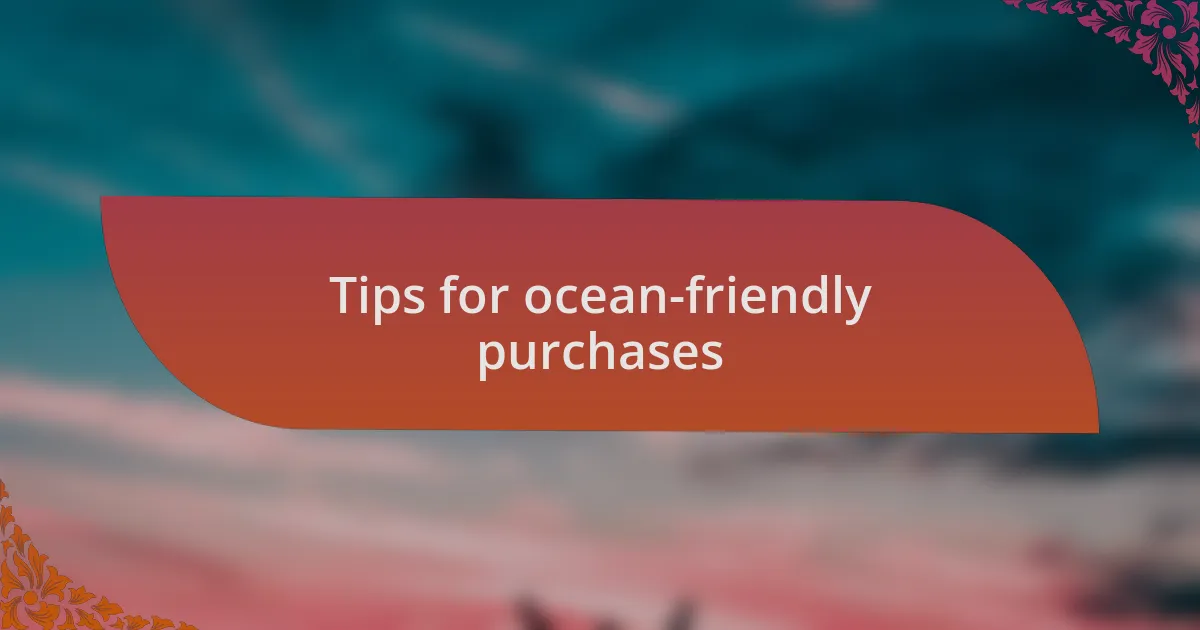
Tips for ocean-friendly purchases
When it comes to making ocean-friendly purchases, I’ve found that focusing on packaging is crucial. I vividly remember unpacking a delivery that was bursting with plastic; it felt disheartening and unnecessary. Now, I actively seek brands that prioritize minimal, biodegradable, or reusable packaging. Not only does it make me feel good about my purchase, but it also reassures me that I’m contributing to less waste that can end up harming marine life.
Another tip I embraced is choosing products made from recycled materials. I once came across a tote bag crafted from ocean-bound plastic, and it sparked a wave of inspiration. Using that bag daily serves as a reminder of the impact my choices can have. Have you thought about how your purchases can help clean up our oceans? It’s empowering to know that even a small switch, like choosing recycled goods, plays a role in this larger fight for conservation.
Lastly, supporting local artisans and brands gives my shopping a deeper meaning. I recall a lovely afternoon spent at a fair, where I met a passionate artist whose jewelry was crafted from responsibly sourced materials. Purchasing from her felt like a twofold victory; I got a unique piece while directly supporting a sustainable practice. Isn’t it incredible how a simple purchase can contribute to a healthier ocean and community?